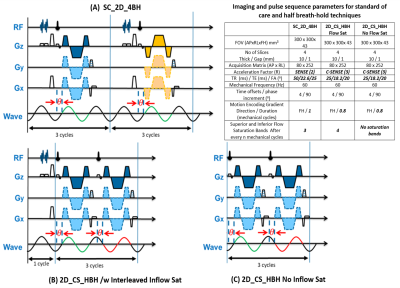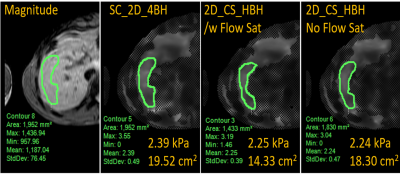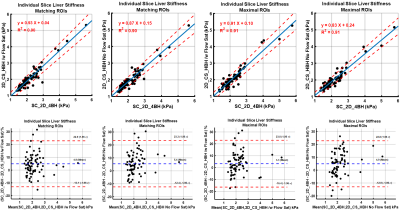2271
Liver Stiffness Measurement in Less Than Half the Conventional Breath-hold Time: Wave Polarity-Inversion Motion Encoding and Compressed SENSE
Amol Pednekar1, Deep B. Gandhi2, Hui Wang3, Jean A. Tkach1, Andrew T. Trout1, and Jonathan R. Dillman1
1Department of Radiology, Cincinnati Children's Hospital Medical Center, Cincinnati, OH, United States, 2Imaging Research Center, Department of Radiology, Cincinnati Children's Hospital Medical Center, Cincinnati, OH, United States, 3MR Clinical Science, Philips, Cincinnati, OH, United States
1Department of Radiology, Cincinnati Children's Hospital Medical Center, Cincinnati, OH, United States, 2Imaging Research Center, Department of Radiology, Cincinnati Children's Hospital Medical Center, Cincinnati, OH, United States, 3MR Clinical Science, Philips, Cincinnati, OH, United States
Synopsis
2D GRE MRE liver images acquired at 4 transverse levels in breath-hold times >13s per slice is currently standard of care (SC_2D_4BH). Inadequate breath-holds lead to inaccurate stiffness estimation and/or failed studies. The combination of wave polarity-inversion motion encoding and compressed-SENSE enables MRE images to be acquired in less than half the breath-hold time (2D_CS_HBH) e.g. <7s, with identical spatial resolution and field of view. In 19 participants, mean liver shear stiffness values estimated with SC_2D_4BH and 2D_CS_HBH correlated very strongly (ICC>0.96) with a bias of <0.15 kPa (<6%). 2D_CS_HBH MRE is beneficial in participants with compromised breath-holding capacity.
Introduction
Magnetic resonance elastography of the liver (MREL) has been shown to aid in the non-invasive diagnosis and staging of liver fibrosis [1]. Two-dimensional (2D) gradient-recalled-echo (GRE) MRE employing: 1) a mechanical driver frequency of 60 Hz, 2) motion encoding gradients (MEG) applied along a single direction, and 3) inflow saturation, acquired during breath-hold (BH) is currently the standard of care (SC) sequence for the assessment of liver fibrosis [2]. Four transverse MREL images through mid-liver are typically acquired in 4 consecutive breath-holds of ~14 – 18sec (SC_2D_4BH) [3]. Given the motion sensitive nature of MREL, inadequate breath-holds lead to inaccurate stiffness estimation and/or failed studies. MREL images can be obtained in less than half the breath-hold time (2D_CS_HBH) e.g. <7s, with identical spatial resolution and field of view by setting the repetition time to 1.5 the period of applied mechanical frequency to encode motion using wave polarity inversion, plus data under-sampling using compressed Sensitivity Encoding (C-SENSE) [4]. The purpose of this study is to compare liver stiffness measurements obtained using SC_2D_4BH technique to those obtained by the 2D_CS_HBH.Methods
In this prospective HIPAA compliant IRB approved study, 19 participants (age 36.9±12.6 years, range 20-62 years, 8 males) underwent MREL imaging with written informed consent. All imaging was performed on a Philips Ingenia 1.5T scanner (Best, The Netherlands), using 28-channel torso coil. MREL images were obtained using both the commercially available SC_2D_4BH MREL sequence (Fig. 1 A) and 2D_CS_HBH MREL sequence with (Fig. 1 B) and without inflow saturation (Fig. 1 C). Commercially available SENSE (based on regular undersampling and coil sensitivity information, and spatial solution space constraint based on prior knowledge of the image extent) and C-SENSE (combines spatial domain variable-density pseudorandom undersampling of k-space with the SENSE reconstruction algorithm using iterative reconstruction and sparsity constraints) were employed [5]. All image reconstructions and stiffness map (using multimodal direct inversion algorithm with 95% confidence interval mask overlays [6]) computations were performed inline in real-time available on the scanner. All the MREL data, including magnitude, phase, and wave images as well as shear stiffness maps, were exported to a post-processing workstation (with IntelliSpace Portal v10.1; ISP, Philips). Manual liver shear stiffness measurements were made by a single trained image analyst (>1-year experience), under the supervision of a board-certified Pediatric Radiologist (>10-years post-fellowship experience). On four slices from each acquisition, a single freehand region of interest (ROI) was drawn to encompass as much of the right hepatic lobe as possible while remaining within the boundaries of the 95% confidence mask and avoiding the liver capsule, large blood vessels, dilated bile ducts, and areas of artifact, including hot-spots immediately under the passive driver and respiratory motion in cases of failed breath holds (Fig. 2). Additionally, to compare the shear stiffness values in the same tissue across the techniques, identically sized and positioned ROIs were drawn on both sets of shear stiffness maps. Overall participant-specific liver shear stiffness was calculated as the ROI area weighted mean liver shear stiffness of the estimates extracted from each slice. Two-sided paired t test, intra-class correlation coefficient (ICC), , and Bland-Altman analysis were used to compare and assess agreement in the ROI sizes and shear stiffness estimates between the sequences.Results
MREL image acquisition and reconstruction was performed successfully in all the participants. Breath-hold times were 13.3 ± 0.2 s per slice with SC_2D_4BH MRE, 6.3 ± 0.2 s with interleaved flow saturation, and 4.9 ± 0.2 s without flow saturation for 2D_CS_HBH techniques. Descriptive and comparative statistics of the liver stiffness values and area within 95% confidence mask are presented in Tables (1-2) and Fig. (3). Area weighted mean liver stiffness estimates for identical tissue ROI for the SC_2D_4BH (2.17 ± 0.68 kPa, range 1.60 – 4.53 kPa) and 2D_CS_HBH with flow saturation (2.04 ± 0.66 kPa, range 1.46 – 4.39 kPa), and without flow saturation (2.03 ± 0.61 kPa, range 1.40 – 4.15 kPa), MRE sequences correlated very strongly (ICC>0.96).Discussion
Liver shear stiffness values obtained by 2D_CS_HBH, with or without flow saturation, correlate very strongly (ICC > 0.96) with stiffness values obtained by SC_2D_4BH, underestimating stiffness significantly (p<0.03) with bias <0.15 kPa (<6%). While all the techniques had identical acquired spatial resolution and coverage, the difference in total ROI area across 4 slices was less than 17 cm2. Liver stiffness values estimated by 2D_CS_HBH with or without flow saturation were comparable (p>0.07). 2D_CS_HBH MREL has the potential to markedly reduce breath hold times, allowing liver stiffness mapping in participants who are only able to perform consistent 5 to 6 second breath-holds. Alternatively, in participants who are able to perform consistent 10 to 12 second breath-hold, the 2D_CS_HBH technique enables either reduced number of breath-holds, or increased coverage relative to the standard 2D_SC_4BH MREL approach.Conclusion
Liver stiffness values measured in less than half (<5-7 s) the standard (>13 s) breath-hold time per slice achieved by the combined use of wave polarity-inversion motion encoding and C-SENSE (2D_CS_HBH) were comparable to liver stiffness values estimated by the standard of care MREL sequence. 2D-CS_HBH MREL has potential clinical benefits in participants with limited and/or compromised breath-holding capabilities.Acknowledgements
No acknowledgement found.References
[1] Singh S et al. Diagnostic performance of magnetic resonance elastography in staging liver fibrosis: a systematic review and meta-analysis of individual participant data. Clinical gastroenterology and hepatology, 2015: 13(3), 440–451. [2] Venkatesh SK. et al. Hepatic MR elastography: Clinical performance in a series of 1377 consecutive examinations. Radiology, Magnetic resonance elastography of liver: technique, analysis, and clinical applications. J Magn Reson Imaging. 2013: 37, 544–555. [3] Yin, M. et al. Hepatic MR elastography: Clinical performance in a series of 1377 consecutive examinations. Radiology, 2016: 278, 114–124. [4] Wang H. et al. Fusing acceleration and saturation techniques with wave amplitude labeling of time-shifted zeniths MR elastography. Magn Reson in Med. 2021: 85(3), 1552-1560, doi: 10.1002/mrm.28488. [5] Geerts-Ossevoort L. et al. A. Compressed SENSE. Speed done right. Every time. Philips Field Strength Magazine, 2018: 278, 6619. [6] Silva AM. et al. A. Magnetic resonance elastography: Evaluation of new inversion algorithm and quantitative analysis method. Abdom Imaging, 2015: 40, 810-817.Figures

Table 1. Area weighted liver shear
stiffness values and total region of interest per participant for SC_2D_4BH and
2D_CS_HBH techniques. Data are reported as the mean ± standard deviation (minimum – maximum). Values are
based on manual analysis informed by a 95% confidence mask with matching ROIs
on images from both techniques and maximal possible ROI in each. SC_2D_4BH: standard
of care two-dimensional 4 slices through mid-liver with 13 second breath-hold
per slice; 2D_CS_HBH: 2D wave polarity-inversion motion encoding plus
compressed SENSE acquisition in half the SC breath-hold.

Table 2. Comparison of area weighted
liver shear stiffness values and total region of interest per participant for SC_2D_4BH
and 2D_CS_HBH techniques. Data are reported as the mean ± standard deviation. Values are based on manual
analysis informed by a 95% confidence mask with matching ROIs on images from
both techniques and maximal possible ROI in each. SC_2D_4BH: 2D standard of
care 4 slices through mid-liver with 13 second breath-hold per slice; 2D_CS_HBH:
2D wave polarity-inversion motion encoding plus compressed SENSE acquisition in
half the SC breath-hold.

Figure 1: Schematic pulse sequence diagrams. (A) SC_2D_4BH: The polarity of MEGs is
reversed (blue and yellow) every RF excitation. The mechanical wave polarity
(green) stays the same across each RF excitation. Each RF excitation triggers 3
motion cycles. (B) 2D_CS_HBH with inflow saturation: The polarity of MEGs
remains the same (blue) across RF excitations. The mechanical wave polarity
inverts (green and red) every RF excitation. (C) 2D_CS_HBH no inflow
saturation. Every other RF excitation triggers 4/3 motion cycles.

Figure 2: Representative magnetic resonance
elastography based shear stiffness maps
with overlaid ROIs from manual
processing for SC_2D_4BH and 2D_CS_HBH
techniques. The associated
mean shear stiffness values for the
contoured ROI are presented on the individual images. SC_2D_4BH: 2D standard of care 4
slices through mid-liver with 13 second breath-hold per slice; 2D_CS_HBH: 2D
wave polarity-inversion motion encoding plus compressed SENSE acquisition in half
the SC breath-hold.

Figure 3: Comparison of liver shear stiffness values
in individual slices for SC_2D_4BH and 2D_CS_HBH techniques by Linear Regression and Bland-Altman Analysis. Values
are based on manual analysis informed by a 95% confidence mask with matching
ROIs on images from both techniques and maximal possible ROI in each. SC_2D_4BH:
standard of care two-dimensional 4 slices through mid-liver with 13 second
breath-hold per slice; 2D_CS_HBH: two-dimensional polarity-inversion motion encoding plus compressed SENSE acquisition in half the SC breath-hold.